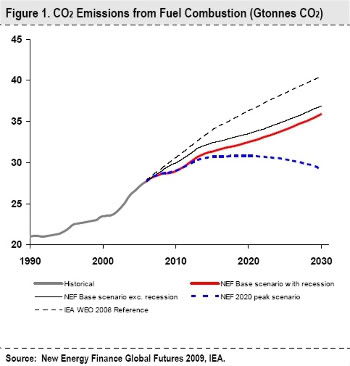|
|
Stalled clean energy investment due to the current recession makes severe climate change more likely, according to a new report by analysts with New Energy Finance (NEF).
Presenting their findings today at the second NEF summit, the analysts suggest that investment in clean energy would need to reach $500 billion by 2020 in order for CO2 emissions to peak in 2020 and decline therefafter. The scenario under which emissions peak by 2020 is what scientific experts have suggested is necessary to avoid the risk of “irreversible” climate change.
 Graph represents CO2 emissions from fuel combustion (Gtonnes CO2). Credit: New Energy Finance Global Futures 2009, IEA. |
However due to the current recession, NEF believes such an investment to be highly unlikely. Currently, investment in clean energy stands about $150 billion for the past two years. NEF predicts that investment will hold steady during the recession and only grow once the crisis has passed. That may prove too late for investment to reach the required figure without substantial action.
NEF admits that the current recession will lessen CO2 emissions globally because several industries are pulling back on projects or shelving them entirely. But they expect the drop in CO2 emissions to be small, around 3 percent, and not enough to off-set slackening investment in clean energy.
If current models hold steady, investment in clean energy should reach $270 billion by 2015, $350 billion by 2020, and $461 billion by 2030, which is far below the investment NEF and climatologists would like to see.
Despite a gloomy prognosis, NEF says that it is possible to reach the $500 billion target figure by 2020 but only through significant acceleration in investment in the midst of what may be the worst economic recession since the 1930s.
Related articles
Wind energy jobs now exceed coal mining jobs
(02/01/2009)
Wind industry jobs now outnumber those in coal mining, reports CNNMoney.
Limiting global warming to 2-degree rise will require $180/t carbon price says energy think tank
(11/13/2008)
In a report released Wednesday the International Energy Agency warned that a business-as-usual approach to energy use would result in a 6°-degree rise in temperatures putting hundreds of millions at risk from reduced water supplies and diminished agricultural production. But the agency said that limiting temperature rise to 2-3°-rise by the end of the century would be “possible, but very hard.”
Challenges of starting a green business
(10/20/2008)
While green design offers the potential to greatly improve the sustainability of new goods and services without sacrificing performance, developing and bringing such products to market is a challenge, said a panel of innovators from companies using nature as inspiration for new technologies. Speaking at the 2008 Bioneers conference in San Rafael, California, Stephen Dewar of WhalePower, Charles Hamilton of Novomer, and Jay Harman of PAX Scientific told biomimicry expert Jane Benyus that radically new approaches to solving design and engineering problems is often met with skepticism from the existing market.
Financial crisis could pave way for greener economy inspired by nature
(10/20/2008)
Biomimicry — the use of nature to inspire design — could serve as a model for a greener economy that rises out of the ashes of the financial crisis, said experts meeting at a sustainability conference in the San Francisco Bay Area. Speaking at the three-day Bioneers conference in San Rafael, Janine Benyus, a leading voice in the emerging field of biomimicry, said that nature offers lessons that can be applied to build better and more sustainable products and services as well as economic models.